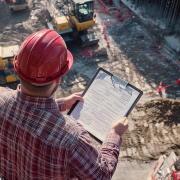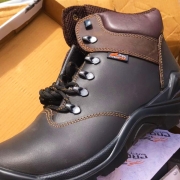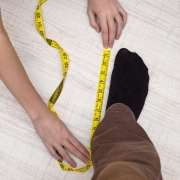Caring For Nubuck Leather: The Art, Science, and Care of the Finest Leathers
Nubuck Leather: The Art, Science, and Care of One of the Finest Leathers
Leather is a material synonymous with durability, luxury, and timeless appeal. Among its many variants, Nubuck leather stands out for its velvety texture, elegant appearance, and distinct tactile quality. But with its delicate finish comes a need for specific care—especially for lighter shades like honeycomb yellow, which can be as stunning as they are tricky to maintain. In this in-depth post, we’ll explore the origins of Nubuck, how it’s manufactured, and the most effective and gentle ways to keep it clean, with a particular focus on using crepe rubber material for maintenance rather than traditional polish.
What is Nubuck Leather?
Nubuck leather is a top-grain leather that has been lightly sanded or buffed on the grain side (the outer layer of the hide), resulting in a soft, velvet-like surface. This differentiates it from suede, which is made from the inner side of the hide and thus has a slightly different feel and durability.
Characteristics of Nubuck:
• Soft, velvety feel: The surface has a nap or pile, similar to suede but more refined.
• Matte finish: Unlike shiny leathers, Nubuck has a matte, understated aesthetic.
• Breathable and porous: While this makes it comfortable to wear or touch, it also means it’s prone to staining and water damage.
• Aging and patina: Nubuck tends to age beautifully, developing a patina over time, but it can also show scuffs and marks more easily than polished leather.
How is Nubuck Leather Made?
The process of transforming raw hide into supple, luxurious Nubuck is both science and craft. Here’s a step-by-step breakdown of how Nubuck leather is manufactured:
• Selection of Hides Only the highest-quality full-grain hides—typically from cows or calves—are selected for Nubuck production. The top grain is the most durable part of the hide, with the densest fiber structure.
• Tanning The hides are treated through vegetable tanning or chrome tanning. Chrome tanning is more common due to its quicker process and softer results, though vegetable-tanned Nubuck does exist for those seeking a more natural, biodegradable option.
• Buffing and Sanding After tanning, the outer grain surface is sanded using fine abrasives. This process raises the nap and gives Nubuck its signature velvet-like surface. Unlike suede, which is sanded on the flesh side, Nubuck retains the stronger grain surface, making it more durable.
• Dyeing Dyes penetrate the leather to achieve the desired color. Because Nubuck is porous, it takes dye well, leading to rich and even color saturation. However, lighter colors like honeycomb yellow require precise control to ensure consistency and avoid blotchiness.
• Finishing Minimal finishing is applied to Nubuck to preserve its natural look and feel. Sometimes, a light protective coating may be added to guard against water and stains, but this is kept minimal to retain the soft surface.
Challenges with Light-Colored Nubuck Leather
Lighter shades like honeycomb yellow, ivory, sand, and beige are visually stunning and modern, but they pose unique challenges:
• They show dirt, dust, and scuffs easily.
• They’re more susceptible to staining from water, oil, and dye transfer.
• Traditional cleaning and polishing methods can darken or damage the pile.
This is where crepe rubber becomes the hero in maintenance.
Caring for Nubuck Leather
Proper care extends the life and beauty of Nubuck leather. Here’s how to keep it looking pristine, especially when you’re working with light colors.
• Avoid Traditional Polish Polish is a staple for maintaining smooth leather—but not Nubuck. Polishes Clog the open pores of the leather, flatten the pile, alter the color and finish and can leave unsightly waxy residue.
For Nubuck, especially light-colored ones like honeycomb yellow, dry cleaning techniques are best.
Why Use Crepe Rubber?
Crepe rubber—a natural rubber with a tacky, flexible consistency—is a gentle and effective way to clean Nubuck leather.
• Benefits of Crepe RubberIt lifts dirt without damaging the nap, it preserves the texture and color of the pile, it is very eco-friendly and chemical-free and is reusable and portable.
How to Use a Crepe Brush on Nubuck Leather
Here’s a step-by-step guide to cleaning honeycomb yellow Nubuck leather using a crepe brush or eraser:
• Step 1: Make Sure the Leather is DryNever try to clean Nubuck while it’s wet. Water can cause permanent stains. Allow it to dry naturally if it’s been exposed to moisture.
• Step 2: Brush Gently in One DirectionUse the crepe brush to gently sweep across the leather in one direction. This lifts surface dirt and refreshes the nap.
• Step 3: Spot Clean with a Nubuck EraserFor darker spots or scuffs, use a crepe rubber eraser in small, circular motions. Apply light pressure to avoid flattening the pile.
• Step 4: Restore the NapAfter spot cleaning, brush the leather again gently to restore the uniform nap.
• Step 5: Apply Nubuck-Protecting Spray (Optional)If you’re wearing or using the item regularly, consider using a nubuck-specific protector spray. Choose a colorless one that won’t darken light shades. Test in an inconspicuous area first.
Additional Tips for Maintaining Honeycomb Yellow Nubuck
• Avoid moisture: Carry a protective spray during rainy seasons.
• Store carefully: Keep it in a dust bag, away from direct sunlight.
• Rotate usage: Avoid overusing one item continuously to prevent wear.
• Don’t condition with oils: Oils will permanently darken the leather.
• Use a suede/nubuck shampoo for deep cleaning (sparingly, and only when dry methods aren’t enough).
Conclusion: The Beauty of Responsibility
Nubuck leather—especially in luminous shades like honeycomb yellow—is a statement of taste. It demands more care, but with the right tools like crepe rubber brushes and erasers, you can keep your leather looking fresh and elegant for years. Avoid shortcuts like polish or generic leather conditioners. Instead, treat Nubuck like the delicate, luxurious material it is. The reward? A uniquely soft, rich texture that only gets better with age—if cared for properly.
Check out our Honeycomb Assassin NSTC and future JS05 Honeycomb Tarantula at our online shop.
________________________________________
For a chat about your work forces safety boot requirements please give us a call on +27 11 892 8030 / 8031 / 8032 or drop an email to organise a call info@profitfootwear.co.za





